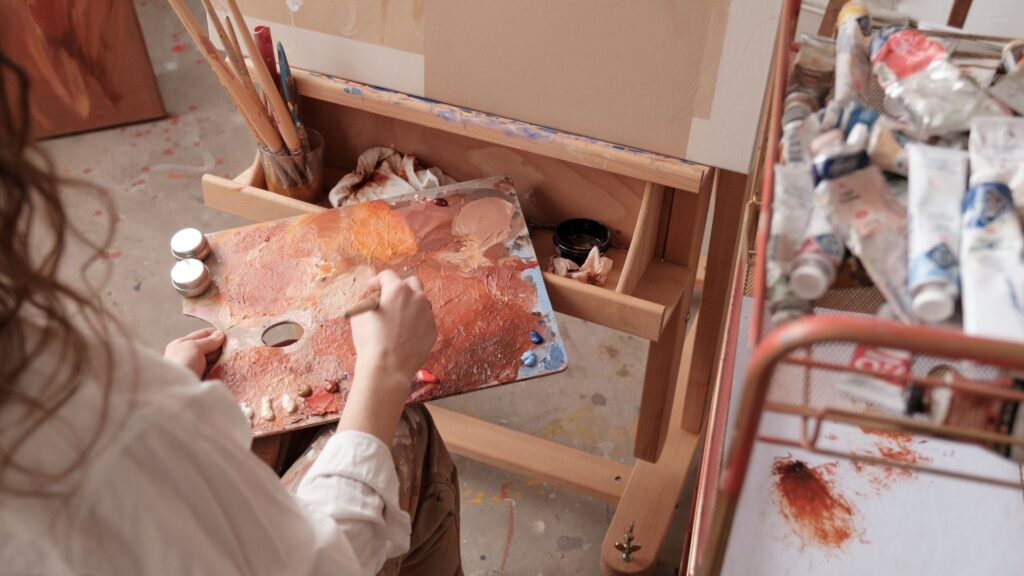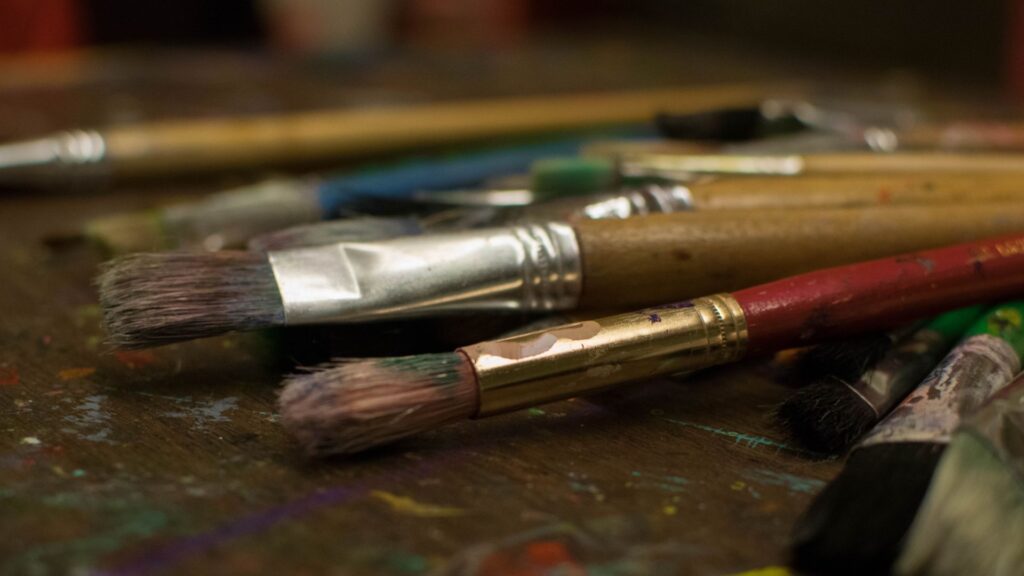
How to choose the right brushes for acrylic and oil painting
Selecting the right brushes is one of the most important decisions you can make when starting a painting, whether you’re working with acrylics or oils. The right brush can make a world of difference in achieving specific textures, details, and effects. With so many brush types, sizes, and materials available, it can be overwhelming, especially for beginners. But with a little guidance, you can choose the perfect brush for your style and technique.
In this article, we’ll take you through the different types of brushes, how to choose the right one for each medium, and how to maintain them for long-lasting use:
- Achieving the best effects for your paintings with the right brushes
- Brush types for acrylic and oil
- Synthetic vs. natural bristles
- Brush size and shape
- Start small and build up to specialised brushes

Achieving the best effects for your paintings with the right brushes
Brushes are essential tools for painters, and selecting the right one can be the key to achieving your desired effects. The type of brush you use will not only affect the texture and finish of your painting but also allow you to control the fluidity, sharpness, and precision of your strokes. Whether you’re using acrylics or oils, choosing the appropriate brush can help you bring your vision to life, whether it’s a detailed portrait or an expressive landscape.
In this guide, we’ll break down the various brush types, sizes, and bristle materials that are ideal for both acrylic and oil painting, and give you tips on how to select the right brush for your specific needs.
“Every artist has their favourite brushes—those tools that feel like an extension of their hand, guiding every stroke with precision and soul. For me, my brushes are not just tools, but companions on a journey to transform a blank canvas into something alive with colour and emotion.”
Brush types for acrylic and oil
There are several types of brushes, each with its own purpose and effect. While the shape and style of a brush may look similar, the way it behaves on the canvas can make a huge difference to the final result. Let’s look at the most common brush types:
Flat Brushes
Flat brushes have a rectangular shape with straight edges, making them perfect for creating bold, defined strokes. They are often used for filling large areas with colour, creating sharp lines, and achieving smooth or geometric shapes.
- For Acrylics: Flat brushes are great for bold strokes, large background areas, or creating straight lines in acrylic painting. Acrylics dry quickly, and a flat brush can help cover large areas with smooth, even coats of paint.
- For Oils: Flat brushes work well in oil painting for laying down a base layer of paint or for painting broad strokes. Their stiff bristles are also useful for creating texture in the paint.
Round Brushes
Round brushes are versatile and come in a range of sizes, from small to large. They are characterised by a pointed tip, making them ideal for detailed work, lines, and thin strokes.
- For Acrylics: Round brushes are great for detail work and fine lines, especially in more intricate areas like faces or detailed landscape elements. They are perfect for creating smooth lines or delicate detail in acrylic painting.
- For Oils: In oil painting, round brushes are often used for glazing, fine detail, and delicate brushwork. Their sharp tip allows for controlled, precise strokes, which is essential for portraiture or any detailed rendering.
Filbert Brushes
Filbert brushes are a combination of flat and round brushes, with an oval shape that tapers to a point. This unique shape allows for both broad strokes and controlled, curved marks.
- For Acrylics: Filbert brushes are excellent for blending and softening edges, making them ideal for creating smooth transitions in acrylic painting, such as in sky or portrait work. They also work well for floral designs, allowing you to create both fine details and broader strokes.
- For Oils: Filberts are widely used in oil painting for both broad strokes and detail work. Their versatility makes them ideal for creating smooth, curved edges, and they work particularly well for blending colours in portraiture and landscapes.
Fan Brushes
Fan brushes have a unique, spread-out shape that mimics the texture of a fan. They are perfect for creating soft, wispy strokes, such as foliage, clouds, or hair.
- For Acrylics: Fan brushes are great for adding texture to backgrounds or creating natural textures like leaves, grass, or water in acrylic painting. They are ideal for capturing the finer details of natural landscapes.
- For Oils: In oil painting, fan brushes are often used to create texture, particularly in landscape paintings, such as for painting tree foliage or adding soft, feathery highlights in the sky.

Synthetic vs. natural bristles
When choosing a brush, the type of bristles can make a big difference in how the paint behaves on the canvas. Brushes come with either synthetic or natural bristles, each offering distinct advantages for different painting techniques.
Synthetic bristles
Synthetic brushes are made from man-made fibres, such as nylon or polyester. They are typically stiffer than natural bristles, making them ideal for acrylic painting, which tends to be thicker and requires more control. Synthetic brushes also tend to be more affordable and are easier to clean.
- For Acrylics: Synthetic brushes are perfect for acrylics because they hold their shape well, and acrylic paints can be more abrasive on natural bristles. They’re also great for applying thicker paints or mediums, and they provide excellent control when working with quick-drying acrylics.
- For Oils: While synthetic brushes work fine for oil painting, many artists prefer natural brushes for their softer, more absorbent quality. However, synthetic brushes are a good choice if you want to avoid using animal hair.
Natural bristles
Natural brushes are made from animal hair, such as sable, hog, or mongoose. These brushes are softer and more absorbent, which makes them ideal for oil painting where smoother, more fluid paint application is needed.
- For Oils: Natural bristles are ideal for oil painting because they can hold more paint and are better suited for blending and smooth strokes. They are perfect for creating soft transitions in oil paints, such as those needed for portrait work or blending large areas in landscapes.
- For Acrylics: While natural bristle brushes can be used with acrylics, they may wear out more quickly due to the abrasive nature of acrylic paints. They are better suited to more fluid mediums like oils.
Brush size and shape
Choosing the right size and shape of brush depends on the scale of your painting and the level of detail you want to achieve. Larger brushes, such as flats and filberts, are perfect for background work or large areas, while smaller round brushes are ideal for fine detail work.
When working on large-scale paintings, using bigger brushes allows you to lay down paint faster and cover more surface area, whereas smaller brushes give you the control needed for intricate details.
Start small and build up to specialised brushes
When building your brush collection, start with a few essential brushes—one or two flat, round, and filbert brushes in varying sizes, and a fan brush for texture. As you become more comfortable with your painting medium, you can add specialty brushes for more detailed work. It’s also important to care for your brushes so they last longer. Clean your brushes regularly with warm water and soap, and make sure to reshape them to keep their form intact.
Let’s recap how to choose the right brushes for your work:
- The type of brush you choose impacts the texture, stroke, and overall finish of your painting. Brushes are available in various shapes and sizes, each suitable for specific tasks like bold strokes, fine details, or textured effects.
- Synthetic brushes are better for acrylics due to their stiffness and durability, while natural brushes are more suited for oils, providing softer, more fluid strokes that are perfect for blending.
- Larger brushes are ideal for covering large areas or backgrounds, while smaller brushes are necessary for precise detail work. The size of the brush should align with the scale of your painting to ensure efficiency and accuracy.
- Start with a basic set of versatile brushes (flat, round, filbert, and fan) in varying sizes, and gradually expand your collection based on your painting style and specific needs.
- Proper care, such as cleaning brushes immediately after use, reshaping bristles, and storing them properly, will ensure your brushes last longer and maintain their performance.
- For acrylics, synthetic brushes are preferred for their quick-drying and thick consistency, while for oils, natural bristle brushes excel in creating smooth, detailed transitions and textures.
Whether you’re using acrylics or oils, the right brush can make all the difference in achieving your desired effect. Take the time to experiment with different brush types, sizes, and bristle materials, and don’t be afraid to invest in a quality set of brushes. With practice, you’ll find the brushes that best suit your style and technique, and your artwork will thank you for it.